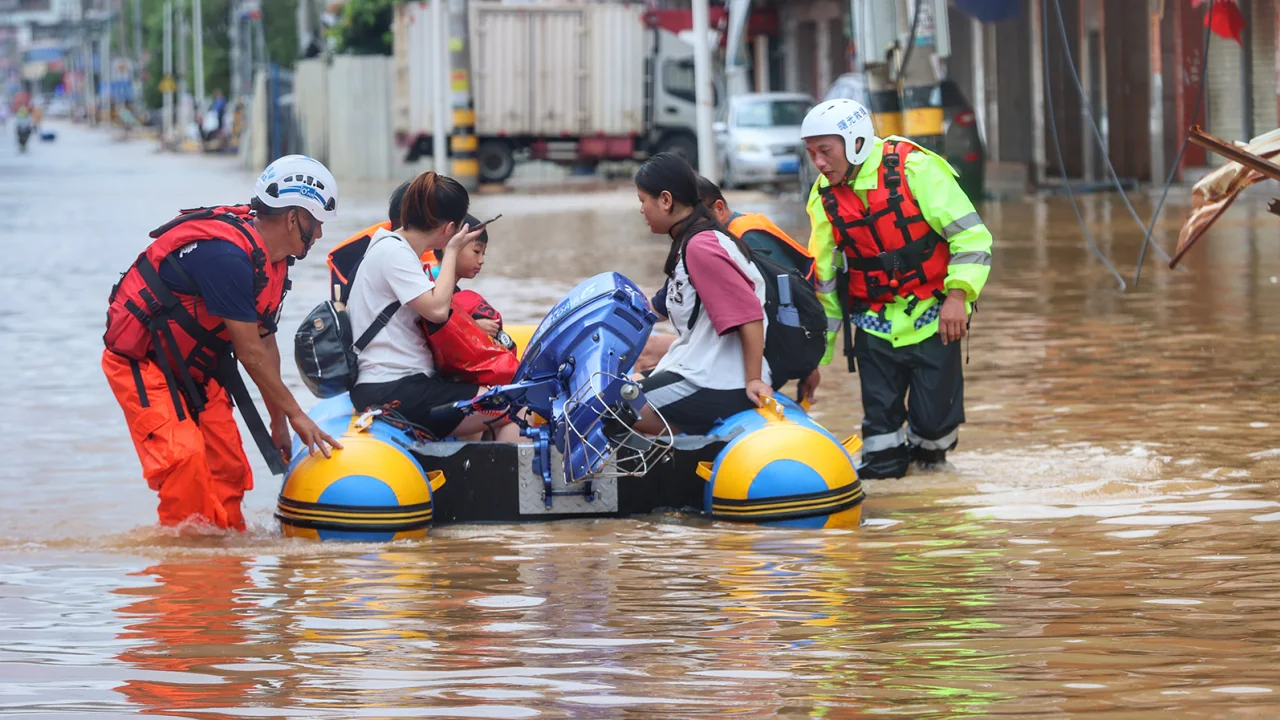After Typhoon Doksuri, one of the strongest storms in years, dumped torrential rain throughout China and forecasters warned another storm with the intensity of a hurricane was on its way, tens of thousands of people evacuated their homes in Beijing.
Similar to much of the rest of the world, China is struggling with this summer’s harsh weather events. This year, heat waves seared China sooner than usual as global temperatures, ocean heat, and sea ice loss all broke records.
Doksuri ploughed into the coastal province of Fujian in the southeast late last week, weakening as it made its way north but dumping copious amounts of rain since Saturday on at least five northern Chinese provinces.
As of Sunday night, more than 31,000 individuals have left the Chinese capital, according to state television station CCTV. According to state news agency Xinhua, another 500,000 residents in the southern province of Fujian had to leave because of flooding.
According to CCTV, two people were killed by the storm and two more went missing while mushrooming in the northeastern Liaoning province.
According to the China Meteorological Administration on Monday, about 40 inches of rain are expected to fall on portions of the capital’s southwest and the nearby province of Hebei, perhaps breaking previous records for precipitation in Beijing.
Through Tuesday, there is a chance for more intense rain, raising worries of landslides and hazardous flooding.
In accordance with the country’s warning system, the weather signal was dropped to the second-highest level in some areas on Monday, but was at the highest level in nine Beijing districts. There were at least 95 other weather alerts issued nationwide.
Numerous railroads and highways in the capital were temporarily shut down as a result of the heavy rains, and residents were advised to stay inside.
According to CNN Weather, based on early data, Doksuri is the most potent typhoon to make landfall in China and the strongest storm to impact Fujian since Typhoon Saomi in 2006. Rita in 1972 was the storm that passed the closest and closest to Beijing.
At least 39 people were killed in the Philippines and sections of southern Taiwan before it made landfall in Fujian.
According to Xinhua, the flooding caused by the rains cost Fujian’s economy approximately $60 million ($428 million yuan) in direct economic losses. According to the state media agency, more than 151 hectares of crop failure occurred on more than 6,333 hectares of farmland in Fujian.
And the future holds little hope for relief. Authorities are getting ready for Khanun, the sixth typhoon predicted to hit China this year, as Doksuri winds down.
As Typhoon Khanun approaches, forecasters anticipate storm tides to affect Zhejiang’s coastal districts from Monday through Thursday. As a result, local authorities activated the lowest of four emergency reaction levels on Monday, according to Xinhua.
The Joint Typhoon Warning Centre has upgraded Khanun to a Category 3-equivalent typhoon as it intensifies in the Pacific Ocean. Over the next two days, it is expected to approach the southern Okinawa islands of Japan and start a lethargic trudge into the East China Sea.
From Monday through Wednesday, more than 200 domestic flights to and from Okinawa’s Naha, Miyako, and Ishigaki islands were cancelled, displacing approximately 30,000 people.
Asia, the largest and most populous continent in the world, is having to deal with the devastating consequences of summer’s harsh weather as its nations experience scorching heatwaves and monsoon rains that set records.
The neighbouring Korean peninsula is experiencing fatal heat waves while most of northeastern China is being swamped by rain.
According to data issued on Sunday by the Korea Disease Control and Prevention Agency (KDCA), at least 10 people have passed away as a result of illnesses brought on by the heat in South Korea, which is suffering from a heat wave that has caused several areas of the country to see their highest temperatures this year.
In South Korea, flash floods and landslides killed at least 41 people just two weeks earlier, including at least 13 from a flooded subway that trapped cars in the downpour.
A total of 1,015 persons experienced heat-related illnesses this past weekend, which the KDCA classifies as heat stroke, heat exhaustion, cramps from the heat, syncope from the heat, and heat edoema.
Around 20% of individuals impacted by the heat were between the ages of 50 and 59, while more than 25% of those affected were 65 years of age or older.
According to the research, more than 35% of the incidents involved people who were engaged in outdoor activity, and 14% involved farms.
The majority of the country has been under heat wave warnings since late July as temperatures soared over the weekend to between 33 and 39 degrees Celsius (about 91 to 102 degrees Fahrenheit).
Many cities recorded their warmest day temperatures of the year on Saturday. According to the Korea Meteorological Administration, temperatures in Gyeongju reached 36.8 degrees Celsius (98.24 degrees Fahrenheit) while in Jeongseon county reached 36.1 degrees Celsius (96.98 degrees Fahrenheit).
Temperatures in the affluent Gangnam neighbourhood of Seoul reached 35.7 degrees Celsius (about 96.2 degrees Fahrenheit), while temperatures in North Gyeongsang Province reached 38.1 degrees Celsius (100.58 degrees Fahrenheit).
On Monday, a heat wave warning is still in effect, indicating that daily maximum temperatures are predicted to be 35 degrees Celsius or higher for at least two days.

